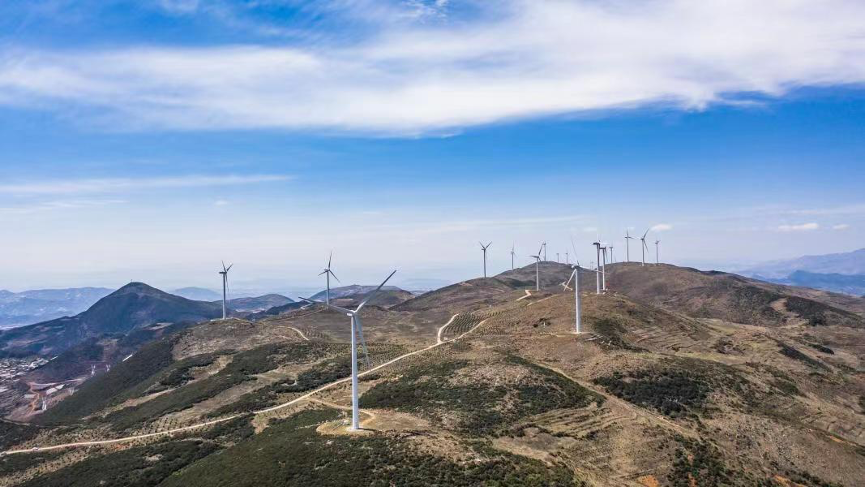
Power-generating windmill turbines in Weining County, southwest China's Guizhou Province. /Xinhua
Power-generating windmill turbines in Weining County, southwest China's Guizhou Province. /Xinhua
Editor's note: Abu Naser Al Farabi, a special commentator on current affairs for CGTN, is a Dhaka-based analyst focusing on international politics, especially Asian affairs. The article reflects the author's opinions and not necessarily those of CGTN.
The 28th Conference of the Parties to the UN Framework Convention on Climate Change (COP28) has commenced in Dubai, United Arab Emirates (UAE), spanning from November 30 to December 12, 2023.
Just several days before this grand climate conference's commencement, a new study report, under the title "China's Belt and Road Initiative Turn away from Coal," was published in early November by Wood Mackenzie Ltd, a renowned global research and consultancy group on energy issues. According to the report, renewables now account for nearly 60 percent of overseas development projects under the BRI that are currently planned or in construction, compared to 37 percent of the capacity built over the last decade.
Over the past decade, Chinese firms have successfully implemented 128 GW of overseas power projects, surpassing the entire generation capacity of the United Kingdom, the report reads. Citing that, over the last ten years, around 70 percent of these projects are concentrated in South and Southeast Asia, the report noted that "There is no doubt that BRI capital, technical expertise, and supply chains have provided a major boost to power capacity across the developing world."
The report also acknowledges a shift in the BRI energy mix, attributing it to China's 2021 commitment to a "No new overseas coal power" policy, with three-quarters of BRI new build projects under construction comprising renewables compared to less than 20 percent a decade ago. Moreover, almost 90 percent of proposed coal-fired projects have already been canceled since China's policy shift in 2021.
While a global contradiction in climate actions persists, notably among historical emitters in the Global North, China stands out for actively promoting climate-centric sustainable development. As the world's second-largest economy, China has pursued extensive environmental policies in line with global climate obligations. This commitment is evident in its trade, investment, and technological cooperation efforts across bilateral, multilateral, and plurilateral engagements, reflecting a keen awareness of the impact its domestic activities have on global climate change.
On the domestic front, China committed to reaching its peak carbon dioxide emissions by 2030 in its initial Nationally Determined Contributions (NDCs) in 2016, a voluntary mechanism for national-level emissions-reduction targets. This was followed by an updated NDC before the COP26 UN climate conference in 2021. China has also committed to becoming carbon neutral by 2060. Climate Action Tracker and other monitoring groups predict that China's emissions will peak soon, years before the country's government promised, leading to far lower per capita emissions than countries like the United States.

People wait outside a building adorned with a COP28 logo ahead of the United Nations climate summit in Dubai, the UAE, November 28, 2023. /VCG
People wait outside a building adorned with a COP28 logo ahead of the United Nations climate summit in Dubai, the UAE, November 28, 2023. /VCG
China's international climate pledge promises to cut its carbon intensity, or emissions per unit of GDP, by "over 65 percent" by 2030 compared to 2005 levels. To achieve this, China has significantly harmonized its national development plan with the sustainable development objectives, including pioneering the world's largest carbon market. Noteworthy strides in reshaping its energy landscape involve a substantial rise in non-fossil energy within the overall energy mix. With remarkable endeavors toward greener energy, China now stands as the foremost global investor in the transition to clean energy.
According to a recent analysis from market research firm BloombergNEF, nearly half of the world's low-carbon spending took place in China, with the country spending $546 billion in 2022 on investments that included solar and wind energy, electric vehicles, and batteries. That amounts to roughly four times as much as U.S. investments, which was $141 billion and represents more than half of the worldwide total ($1 trillion). According to the same data, China accounted for more than 90 percent of the $79 billion spent in that industry last year, making it the leader in low-carbon manufacturing as well.
The outcomes are exceptionally eye-popping. China achieved a remarkable 34.4 percent reduction in carbon dioxide emissions per unit of GDP from 2012 to 2021, coupled with a 26.4 percent decrease in energy consumption per unit of GDP. Although there was a 4 percent increase in carbon dioxide emissions in the first quarter of 2023 compared to the same period in 2022, primarily due to post-COVID-19 economic expansion, the overarching trend indicates that the country remains on course to fulfill its climate sustainability goals well before the targeted timeframe.
According to the latest report, "How China Became the Global Renewables Leader" by Wood Mackenzie, China is poised to achieve an unprecedented milestone with an anticipated record-breaking installation of 230 gigawatts (GW) in wind and solar energy this year, solidifying its position as the global leader in renewables. Remarkably, this surpasses the combined installations of the United States and Europe, exceeding their figures twofold.
Moreover, recent reports revealed that China's non-fossil fuel energy sources have now exceeded 50 percent of its total installed electricity generation capacity, marking an early achievement of the objective set in 2021 to surpass fossil fuels by 2025. As noted in the Government Work Report, its consumption proportion of clean energy (solar, wind, nuclear, hydro, and biomass) climbed from 20.8 percent to 25.5 percent during the previous five years. Additionally, more than 1.05 billion kilowatts of coal-fired power have been upgraded to the most advanced and effective ultra-supercritical technology.
Despite 23 affluent, developed nations being accountable for half of all historical carbon dioxide emissions, their climate actions have not matched their culpability. In contrast, despite being a developing economy with minimal historical responsibility for global warming, China showcases a commendable and robust climate response, both domestically and in its international engagements, serving as a noteworthy example for emulation. The true essence of a responsible stakeholder is vividly demonstrated through China's actions in promoting a sustainable future globally, actively embracing and adopting green goals both at home and abroad.
(If you want to contribute and have specific expertise, please contact us at opinions@cgtn.com. Follow @thouse_opinions on Twitter to discover the latest commentaries in the CGTN Opinion Section.)





















